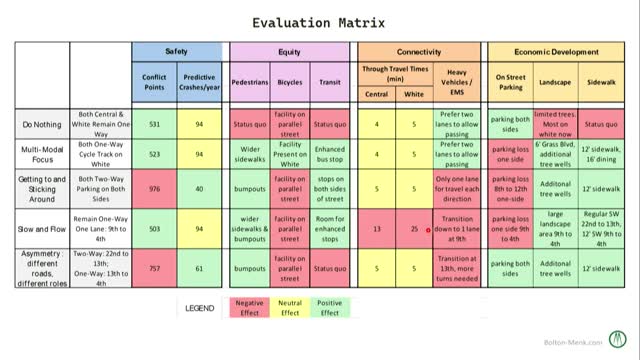City plans major transportation overhaul to ease congestion
September 30, 2024 | Dubuque City, Dubuque County, Iowa
This article was created by AI summarizing key points discussed. AI makes mistakes, so for full details and context, please refer to the video of the full meeting. Please report any errors so we can fix them. Report an error »

In a recent government meeting, officials discussed the complexities of urban planning and transportation management in an aging city, emphasizing the need for balance between various community needs. The conversation highlighted the limited right-of-way available for development, which poses challenges for accommodating parking, sidewalks, and travel lanes.
Key findings from the meeting indicated that while projected travel times for 2050 show only minor delays—approximately a minute and a half during rush hour—this data is contingent on regional growth predictions that remain uncertain. The discussions underscored the importance of understanding how different users interact with the corridor, noting that many residents and businesses do not travel the full length of the route but rather stop along the way.
The officials also addressed the necessity of accommodating freight traffic, which requires specific geometric changes at intersections to facilitate truck movement. They proposed that side streets could play a crucial role in alleviating pressure on main thoroughfares by providing additional parking, plaza space, or green areas without significantly impacting transportation flow.
The meeting concluded with a call for a commitment to developing north-south bike facilities, which are deemed essential for the city's infrastructure. Overall, the discussions reflected a comprehensive approach to urban planning, aiming to reclaim central streets for local benefits while ensuring efficient transportation across the city.
Key findings from the meeting indicated that while projected travel times for 2050 show only minor delays—approximately a minute and a half during rush hour—this data is contingent on regional growth predictions that remain uncertain. The discussions underscored the importance of understanding how different users interact with the corridor, noting that many residents and businesses do not travel the full length of the route but rather stop along the way.
The officials also addressed the necessity of accommodating freight traffic, which requires specific geometric changes at intersections to facilitate truck movement. They proposed that side streets could play a crucial role in alleviating pressure on main thoroughfares by providing additional parking, plaza space, or green areas without significantly impacting transportation flow.
The meeting concluded with a call for a commitment to developing north-south bike facilities, which are deemed essential for the city's infrastructure. Overall, the discussions reflected a comprehensive approach to urban planning, aiming to reclaim central streets for local benefits while ensuring efficient transportation across the city.
View full meeting
This article is based on a recent meeting—watch the full video and explore the complete transcript for deeper insights into the discussion.
View full meeting
